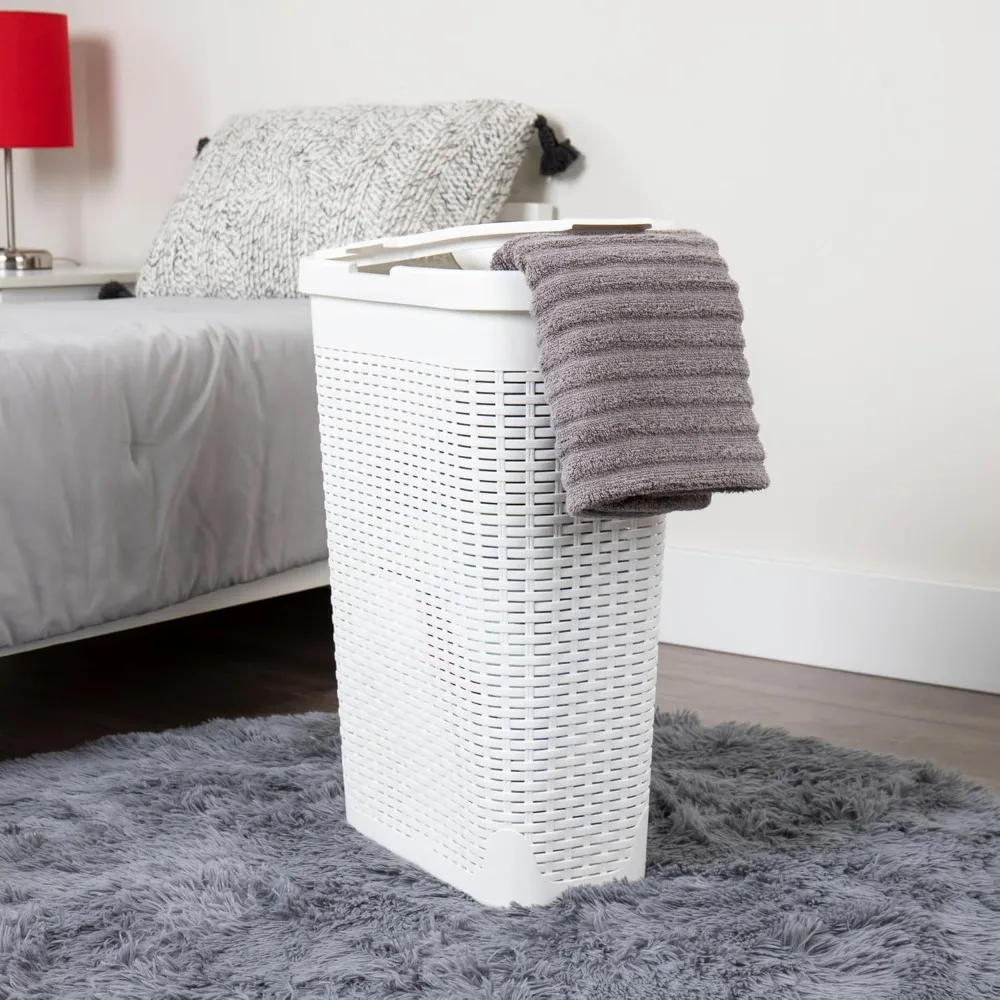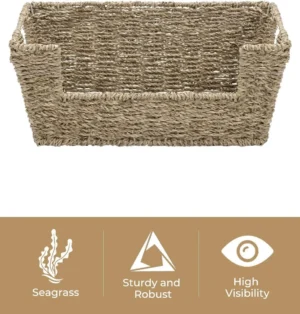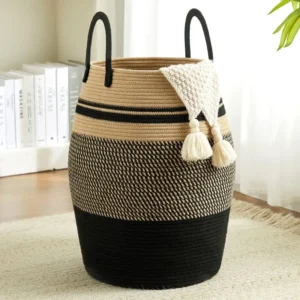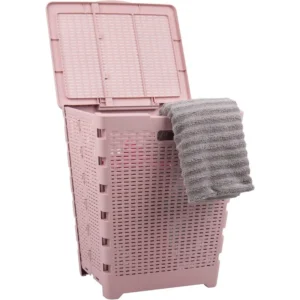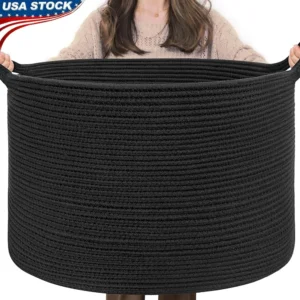When it comes to organizing laundry, choosing the right storage solution can make all the difference in maintaining a tidy home. Synthetic wicker baskets have become increasingly popular for laundry storage, but many homeowners wonder about their safety and suitability. This comprehensive guide explores whether synthetic wicker is truly safe for storing your laundry items and helps you make an informed decision.
Understanding Synthetic Wicker Materials and Composition
Synthetic wicker refers to manufactured materials designed to mimic the appearance and texture of natural wicker while offering enhanced durability and weather resistance. Unlike natural wicker made from plant materials, synthetic versions are created from various plastic compounds.
The most common materials used in synthetic wicker production include:
- Polyethylene (PE): High-density PE is known for its exceptional durability and UV resistance, making it the premium choice for synthetic wicker. It’s typically 95-100% water-resistant and has a durability rating of 7-10 years.
- Polypropylene (PP): Offering good flexibility and moderate durability, PP provides a more affordable option with water resistance of approximately 90-95%.
- Polyvinyl Chloride (PVC): Often used in lower-cost options, PVC offers decent water resistance but may become brittle over time.
You may encounter various terms when shopping for synthetic wicker products, including “resin wicker,” “all-weather wicker,” or “faux wicker” – all referring to synthetic materials made to resemble natural wicker.
The contrast with natural wicker vs synthetic options is significant. Natural materials like rattan, reed, and bamboo offer organic beauty but lack the moisture resistance and durability of synthetic alternatives. The manufacturing process for synthetic wicker involves extruding plastic materials into thin strands that are then woven around frames, creating the distinctive woven appearance we associate with wicker.
Understanding these fundamental differences between synthetic vs natural wicker provides essential context for evaluating their safety for laundry storage.
Chemical Safety of Synthetic Wicker for Laundry Items
When considering synthetic wicker for laundry storage, chemical safety is a primary concern. Fortunately, high-quality synthetic wicker made from PE or PP is generally considered non-toxic and chemically stable. These materials don’t readily leach chemicals into the environment or onto items stored within them.
Quality synthetic wicker products are manufactured to be inert, meaning they don’t react with other materials or release harmful substances under normal conditions. Premium options often meet strict safety standards that limit the use of potentially harmful additives.
Off-gassing concerns are minimal with higher-end synthetic wicker products. While new synthetic products may have a slight “plastic” smell initially, this typically dissipates quickly and doesn’t indicate a safety issue. Indoor-grade synthetic wicker is specifically formulated to minimize any potential off-gassing.
When evaluating different laundry basket materials, consider this comparison of chemical properties:
| Material | Chemical Stability | Off-Gassing Potential | Safe for Clothing Contact | Recommended Use |
|---|---|---|---|---|
| PE Synthetic Wicker | High | Very Low | Yes | Indoor/Outdoor |
| PP Synthetic Wicker | High | Low | Yes | Indoor/Outdoor |
| PVC Synthetic Wicker | Moderate | Moderate | Yes (with proper manufacturing) | Indoor |
| Natural Wicker | High | None | Yes (when dry) | Indoor only |
To identify quality synthetic wicker products, look for:
– Certifications from recognized safety organizations
– Even, consistent weaving patterns
– Smooth edges without sharp points
– Manufacturer statements about non-toxic materials
Higher-grade synthetic wicker designed specifically for indoor use tends to have stricter safety requirements than outdoor varieties, making them ideal for laundry storage.
Moisture and Mold Resistance Benefits
One of the greatest advantages of synthetic wicker for laundry storage is its exceptional resistance to moisture and mold—a crucial feature for any laundry storage solution.
Unlike natural wicker, which can absorb water and create a breeding ground for mold and mildew, synthetic wicker repels moisture. This water-resistant quality makes synthetic wicker particularly valuable in laundry environments where dampness is common. Consider these impressive statistics:
- High-quality synthetic wicker typically repels 95-100% of moisture exposure
- Natural wicker can absorb up to 30% of its weight in water
- Synthetic wicker maintains its structural integrity even after repeated exposure to humidity
This moisture resistance directly benefits your laundry items by:
– Preventing mold spores from transferring to clean clothes
– Eliminating the risk of moisture damage to stored textiles
– Maintaining a hygienic environment for both clean and soiled laundry
The differences between natural and synthetic wicker for laundry become particularly apparent in humid environments. While natural wicker requires regular drying and maintenance to prevent warping and mold growth, synthetic alternatives remain stable and hygienic with minimal care.
For optimal performance, choose synthetic wicker laundry hampers with design features that enhance airflow. Proper ventilation works alongside the material’s inherent moisture resistance to create an ideal storage environment for your laundry items.
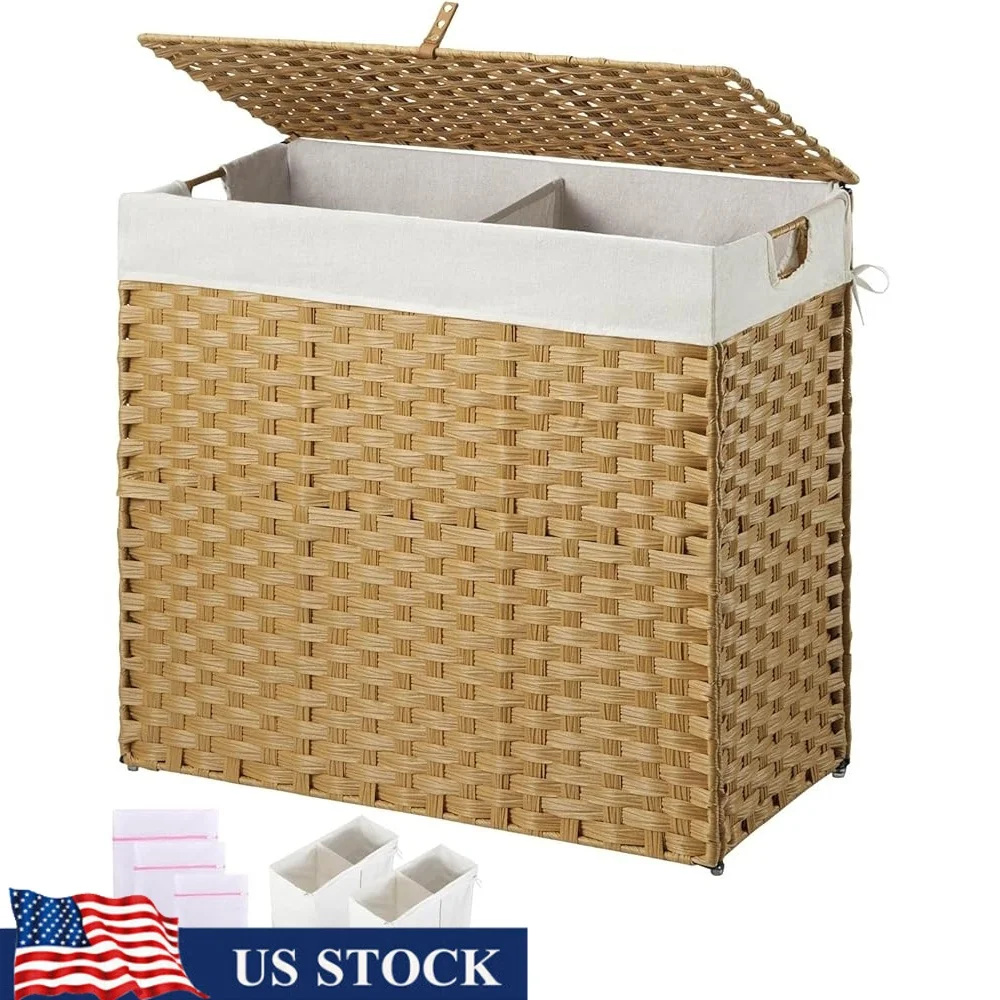
Odor Control Capabilities and Ventilation
The distinctive woven design of synthetic wicker offers excellent ventilation—a key feature for preventing odor buildup in laundry storage. This inherent airflow is complemented by synthetic materials’ non-absorbent nature, which prevents them from trapping and retaining odors the way fabric hampers might.
Proper ventilation in laundry storage serves multiple purposes:
– Allows moisture to evaporate from slightly damp items
– Prevents musty odors from developing
– Reduces the risk of bacterial growth that can cause unpleasant smells
– Creates a healthier environment for storing both clean and dirty laundry
To maximize freshness when using synthetic wicker for laundry storage:
– Choose designs with adequate spacing between weaves
– Opt for hampers with ventilated sides rather than solid panels
– Consider wicker laundry baskets with lids that still allow for air circulation
– Place your laundry hamper in a location with good air movement
– Avoid overcrowding the hamper, which can restrict airflow
For particularly damp items, it’s still best to allow them to dry completely before placing them in any hamper, including synthetic wicker ones. However, synthetic wicker handles occasional dampness much better than alternative materials, making it forgiving of slightly damp items that might find their way into the hamper.
The combination of material resistance to moisture absorption and the ventilated design creates an environment that naturally controls odors better than many alternative laundry storage options.
Durability and Longevity in Laundry Environments
Synthetic wicker excels in durability, particularly in the challenging conditions often found in laundry environments. This resilience translates directly to value and safety for your laundry storage needs.
The structural integrity of quality synthetic wicker allows it to support substantial weight without sagging or breaking. High-grade synthetic wicker hampers can typically hold 20-30 pounds of laundry without compromising their structure—more than enough for normal household use.
Key durability advantages include:
- Resistance to cracking and splitting, even with daily use
- Ability to withstand humidity fluctuations in bathrooms and laundry rooms
- Color stability that prevents fading from light exposure
- Flexibility that allows the material to absorb impacts without breaking
- Consistent performance across seasonal temperature and humidity changes
When comparing lifespan expectations, the differences between synthetic and natural wicker become clear:
- Quality synthetic wicker laundry hampers typically last 7-10 years with proper care
- Natural wicker in similar applications may need replacement after 2-4 years
- Fabric hampers often show wear and staining within 1-2 years
For optimal durability, look for synthetic wicker with:
– Tight, consistent weaving patterns
– Reinforced edges and corners
– UV-stabilized materials (even for indoor use)
– Sturdy framework supporting the woven exterior
This exceptional durability not only provides better value but also ensures your laundry storage remains safe and functional for years, without developing structural issues that could damage clothing or create safety hazards.
Practical Advantages for Laundry Organization
Beyond safety considerations, synthetic wicker offers numerous practical advantages that make it particularly well-suited for laundry organization.
Maintenance simplicity stands out as a major benefit. Synthetic wicker can be quickly cleaned with a damp cloth and mild soap, then dried immediately. Unlike fabric hampers that require machine washing or natural wicker that needs specialized cleaning, synthetic options can be maintained in minutes, ensuring your laundry storage remains hygienic.
The construction of synthetic wicker creates a perfect balance of lightweight design with sturdy structure. Most synthetic wicker hampers weigh 50-70% less than solid plastic alternatives of similar size, making them easy to move even when full of laundry. This mobility becomes particularly valuable when transporting clothes to and from laundry areas.
Additional practical benefits include:
- Smooth surfaces that prevent clothing snags common with natural wicker
- Versatile aesthetic options that complement various home décor styles
- Available in diverse sizes for different household needs
- Easy integration with both modern and traditional interior design
- Resistance to detergent spills and laundry chemicals
For effective laundry organization, many homeowners find wicker baskets for laundry organization offer the perfect combination of functionality and style. Options range from small bins for sorting specific items to large hampers for family-sized loads.
The visual appeal of synthetic wicker also means these storage solutions don’t need to be hidden away, allowing for convenient placement in bedrooms or bathrooms while still maintaining an attractive appearance.
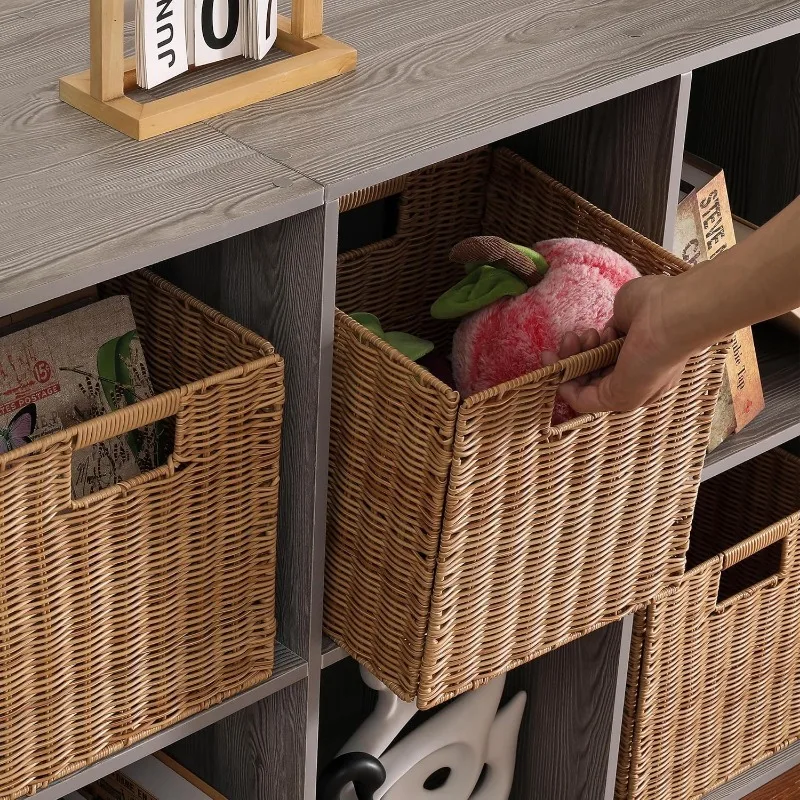
Potential Considerations and Limitations
While synthetic wicker offers numerous advantages for laundry storage, it’s important to consider potential limitations to make a fully informed decision.
From an environmental perspective, synthetic wicker presents some considerations:
– Made from petroleum-based plastics, a non-renewable resource
– Typically not biodegradable
– Varies in recyclability depending on specific materials
Recyclability differs across synthetic wicker materials:
– High-density PE is widely accepted in many recycling programs
– PP is recyclable in many but not all facilities
– PVC has more limited recycling options
Some homeowners prefer the natural aesthetic and feel of traditional wicker despite its functional limitations. Natural materials offer an organic warmth that synthetics can mimic but not fully replicate.
Cost considerations also factor in, as quality synthetic wicker products typically represent a higher initial investment compared to basic fabric or plastic options. However, their extended lifespan often makes them more economical over time.
For environmentally conscious consumers, exploring eco-friendly wicker basket materials may reveal alternatives that balance practical needs with sustainability concerns. Some manufacturers now offer synthetic wicker made partly from recycled materials or newer bioplastic alternatives that reduce environmental impact while maintaining performance benefits.
Comparing Synthetic Wicker to Alternative Laundry Storage Materials
Understanding how synthetic wicker compares to alternative materials helps put its advantages and limitations in context. This comparison highlights the unique position synthetic wicker occupies in the laundry storage market.
| Feature | Synthetic Wicker | Natural Wicker | Plastic Containers | Fabric Hampers | Metal Baskets |
|---|---|---|---|---|---|
| Moisture Resistance | Excellent (5/5) | Poor (1/5) | Excellent (5/5) | Fair (2/5) | Good w/coating (4/5) |
| Ventilation | Excellent (5/5) | Good (4/5) | Poor (1/5) | Fair (3/5) | Good (4/5) |
| Durability | Very Good (4/5) | Fair (2/5) | Good (3/5) | Poor (1/5) | Very Good (4/5) |
| Cleaning Ease | Very Good (4/5) | Fair (2/5) | Excellent (5/5) | Good (3/5) | Good (3/5) |
| Aesthetics | Excellent (5/5) | Excellent (5/5) | Poor (1/5) | Good (3/5) | Good (3/5) |
| Cost-Value Ratio | Good (4/5) | Fair (2/5) | Excellent (5/5) | Fair (3/5) | Good (4/5) |
Each material offers distinct advantages for different situations:
- Synthetic wicker excels in providing a balance of functionality and appearance
- Natural wicker offers unmatched aesthetic appeal but with functional compromises
- Plastic containers provide maximum moisture protection but limited ventilation
- Fabric hampers offer softness and variety but limited durability
- Metal options provide strength but may pose rust concerns in humid environments
When choosing between synthetic and natural wicker, consider your specific laundry environment and needs. Bathrooms with frequent high humidity benefit most from synthetic wicker’s moisture resistance, while dry areas might allow for natural wicker options if aesthetic preference is paramount.
For households with children, synthetic wicker’s durability and easy cleaning make it particularly advantageous over fabric alternatives that might stain or tear more easily.
Wicker Laundry Baskets, Woven Laundry Baskets, Woven Storage Baskets
$392.02 Select options This product has multiple variants. The options may be chosen on the product pageWicker Baskets with Handles, Wicker Storage Baskets, Woven Storage Baskets
$137.92 Select options This product has multiple variants. The options may be chosen on the product pageLarge Wicker Laundry Baskets, Tall Wicker Baskets, Woven Laundry Hampers, Woven Storage Baskets
$130.54 Select options This product has multiple variants. The options may be chosen on the product pageWoven Laundry Baskets, Woven Laundry Washing Baskets
Price range: $136.76 through $581.37 Select options This product has multiple variants. The options may be chosen on the product pageWicker Hampers with Lids, Wicker Laundry Baskets with Lids, Wicker Laundry Hampers
$127.33 Select options This product has multiple variants. The options may be chosen on the product pageWicker Blanket Baskets, Woven Laundry Baskets
$89.60 Select options This product has multiple variants. The options may be chosen on the product page
Expert Tips for Choosing Quality Synthetic Wicker Laundry Storage
Selecting the right synthetic wicker laundry storage requires knowing what distinguishes quality products from inferior alternatives. These expert tips will help you make a selection that’s both safe and long-lasting.
Inspect the weaving pattern – Quality synthetic wicker features tight, consistent weaving without gaps, loose ends, or irregularities. The more uniform the pattern, the better the construction quality.
Check joint construction – Examine where the wicker attaches to the frame. Well-made pieces secure the woven material firmly to prevent unraveling even with frequent use.
Evaluate weight capacity – Quality synthetic wicker laundry hampers should support at least 20-25 pounds without showing stress or deformation.
Look for reinforced handles – Handles should be reinforced and securely attached to support the weight of full laundry loads during transport.
Consider ventilation design – Optimal designs balance adequate airflow with attractive appearance, typically featuring strategic spacing in the weave pattern.
For laundry-specific features, consider whether you need a laundry solution with:
– Removable liner bags for easy transport to washing machines
– Sorting compartments for separating different laundry types
– Lids to conceal contents while maintaining ventilation
– Stackable design for space efficiency
To ensure longevity, look for synthetic wicker with UV-stabilized materials (even for indoor use) as this prevents yellowing or brittleness over time. Water-resistant coatings further enhance performance in humid environments like bathrooms and laundry rooms.
Tidy Treasure offers synthetic wicker options specifically engineered for laundry environments, with designs that balance functionality, durability, and aesthetic appeal.
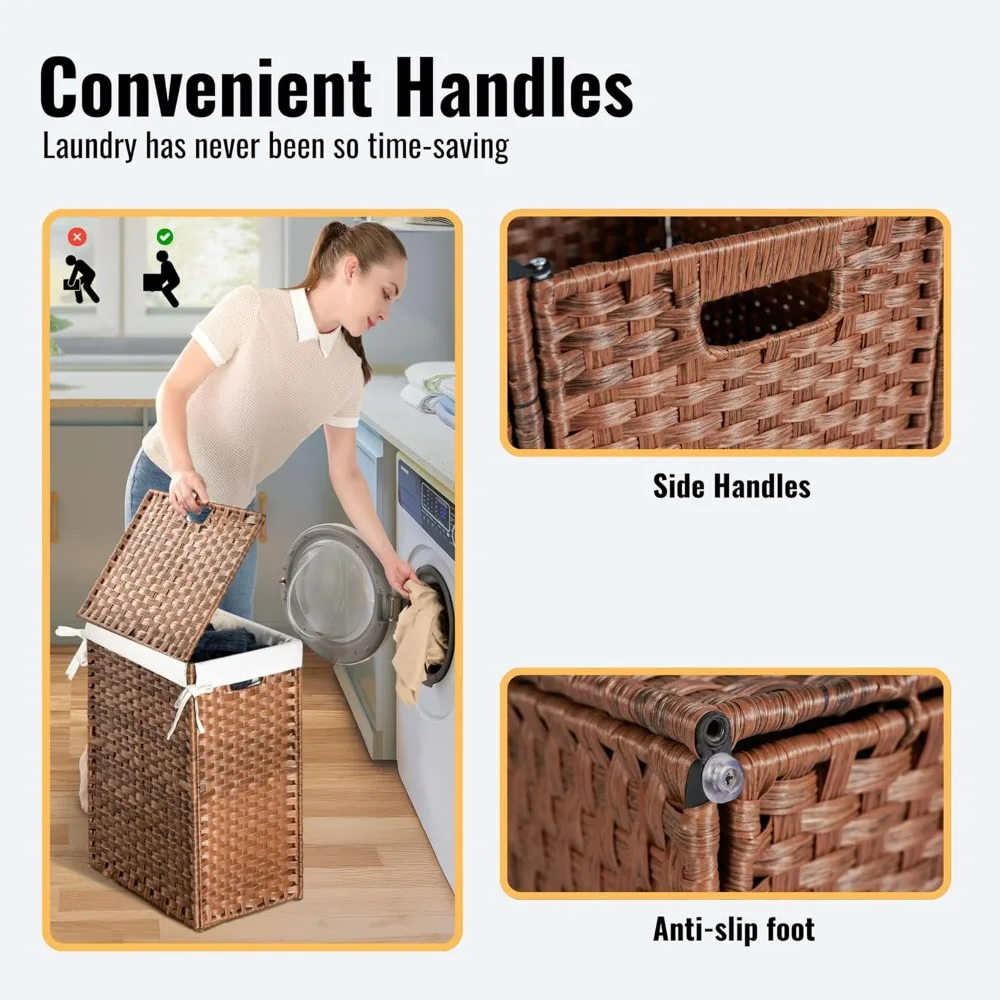
Frequently Asked Questions About Synthetic Wicker for Laundry
Is synthetic wicker toxic or harmful to clothing?
High-quality synthetic wicker made from PE or PP is non-toxic and safe for clothing contact. These materials are chemically stable and don’t transfer substances to fabrics under normal conditions.
How do I clean synthetic wicker laundry baskets?
Clean with a damp cloth and mild soap, rinse lightly, and dry immediately. For deeper cleaning, use a soft brush to reach between weaves. Avoid harsh chemicals that may break down the material.
Can synthetic wicker really prevent mold in laundry storage?
Yes, synthetic wicker significantly reduces mold risk compared to natural materials because it doesn’t absorb moisture. However, proper ventilation and avoiding storage of soaking wet items remain important.
What’s the difference between resin wicker and synthetic wicker?
“Resin wicker” is a type of synthetic wicker, specifically referring to plastic materials molded to resemble natural wicker. All resin wicker is synthetic, but manufacturers may use different terminology for marketing purposes.
Is synthetic wicker environmentally friendly?
Traditional synthetic wicker has a larger environmental footprint than natural materials. However, newer options made with recycled plastics or bioplastics offer more eco-friendly alternatives while maintaining performance benefits.
Can I store damp towels in synthetic wicker baskets?
Slightly damp items are generally fine in ventilated synthetic wicker baskets, but very wet items should be dried first to prevent potential odor development despite the material’s resistance to moisture damage.
Explore wicker laundry hampers for options specifically designed to address these common concerns.
Environmental Considerations for Synthetic Wicker Products
When evaluating synthetic wicker for laundry storage, environmental impact deserves thoughtful consideration alongside practical benefits.
The recyclability of synthetic wicker varies by material:
– PE (code #2 or #4) is widely accepted in recycling programs
– PP (code #5) is increasingly recyclable as facilities expand capabilities
– PVC (code #3) presents more recycling challenges and limitations
The extended lifespan of quality synthetic wicker does contribute positively to its environmental profile. A single synthetic wicker hamper that lasts 7-10 years replaces multiple natural wicker or fabric alternatives that might otherwise end up in landfills.
Recent innovations have introduced more eco-conscious synthetic wicker options:
– Partially recycled plastic content
– Bioplastic blends that reduce petroleum dependence
– Manufacturing processes with reduced carbon footprints
For environmentally conscious consumers, woven laundry baskets now include options with improved sustainability profiles without sacrificing the practical benefits that make synthetic wicker attractive for laundry storage.
Special Considerations for Damp Laundry Storage
While synthetic wicker offers excellent resistance to moisture, proper practices for storing damp laundry help maximize both the lifespan of your storage solution and the freshness of your laundry.
Best practices for damp laundry include:
– Allow extremely wet items to pre-dry before placing in any hamper
– Choose synthetic wicker designs with enhanced ventilation for damp environments
– Position hampers where air can circulate freely around them
– Consider models with removable, washable liners for frequently damp items
– Periodically empty and air out hampers used for damp items
In particularly humid environments like bathrooms:
– Select synthetic wicker with wider spacing between weaves for maximum airflow
– Consider raised designs that allow air circulation beneath the basket
– Avoid overcrowding, which restricts airflow regardless of material quality
For specialized needs, wicker storage baskets are available with varying ventilation designs suitable for different moisture conditions, from standard bedroom use to humid bathroom environments.
With proper selection and use, synthetic wicker provides an ideal balance of moisture resistance, ventilation, and durability that makes it one of the safest and most practical options for laundry storage in virtually any home environment.

